Molecular Design Concept for Enhancement Charge Carrier Mobility in OFETs: A Review
Abstract
:1. Introduction
2. Backbone
3. Side Chains Engineering
4. Ohmic Contact
5. Conclusions and Outlook
Funding
Institutional Review Board Statement
Informed Consent Statement
Data Availability Statement
Conflicts of Interest
References
- Shin, M.; Song, J.H.; Lim, G.H.; Lim, B.; Park, J.J.; Jeong, U. Highly Stretchable Polymer Transistors Consisting Entirely of Stretchable Device Components. Adv. Mater. 2014, 26, 3706–3711. [Google Scholar] [CrossRef]
- Zheng, Y.; Wang, G.N.; Kang, J.; Nikolka, M.; Wu, H.; Tran, H.; Zhang, S.; Yan, H.; Chen, H.; Yuen, P.Y.; et al. An Intrinsically Stretchable High-Performance Polymer Semiconductor with Low Crystallinity. Adv. Funct. Mater. 2019, 29, 1905340. [Google Scholar] [CrossRef]
- Su, W.P.; Schrieffer, J.R.; Heeger, A.J. Soliton Excitations in Polyacetylene. Phys. Rev. B 1980, 22, 2099–2111. [Google Scholar] [CrossRef]
- Wu, Y.; Zhao, Y.; Liu, Y. Toward Efficient Charge Transport of Polymer-Based Organic Field-Effect Transistors: Molecular Design, Processing, and Functional Utilization. Acc. Mater. Res. 2021, 2, 1047–1058. [Google Scholar] [CrossRef]
- Li, J.; Zhao, Y.; Tan, H.S.; Guo, Y.; Di, C.A.; Yu, G.; Liu, Y.; Lin, M.; Lim, S.H.; Zhou, Y.; et al. A Stable Solution-Processed Polymer Semiconductor with Record High-Mobility for Printed Transistors. Sci. Rep. 2012, 2, 754. [Google Scholar] [CrossRef]
- Luo, C.; Kyaw, A.K.K.; Perez, L.A.; Patel, S.; Wang, M.; Grimm, B.; Bazan, G.C.; Kramer, E.J.; Heeger, A.J. General Strategy for Self-Assembly of Highly Oriented Nanocrystalline Semiconducting Polymers with High Mobility. Nano Lett. 2014, 14, 2764–2771. [Google Scholar] [CrossRef]
- Bucella, S.G.; Luzio, A.; Gann, E.; Thomsen, L.; McNeill, C.R.; Pace, G.; Perinot, A.; Chen, Z.; Facchetti, A.; Caironi, M. Macroscopic and High-Throughput Printing of Aligned Nanostructured Polymer Semiconductors for MHz Large-Area Electronics. Nat. Commun. 2015, 6, 8394. [Google Scholar] [CrossRef]
- Zhang, F.; Di, C.; Berdunov, N.; Hu, Y.; Hu, Y.; Gao, X.; Meng, Q.; Sirringhaus, H.; Zhu, D. Ultrathin Film Organic Transistors: Precise Control of Semiconductor Thickness via Spin-Coating. Adv. Mater. 2013, 25, 1401–1407. [Google Scholar] [CrossRef]
- Yi, Z.; Sun, X.; Zhao, Y.; Guo, Y.; Chen, X.; Qin, J.; Yu, G.; Liu, Y. Diketopyrrolopyrrole-Based π-Conjugated Copolymer Containing β-Unsubstituted Quintetthiophene Unit: A Promising Material Exhibiting High Hole-Mobility for Organic Thin-Film Transistors. Chem. Mater. 2012, 24, 4350–4356. [Google Scholar] [CrossRef]
- Yi, Z.; Ma, L.; Chen, B.; Chen, D.; Chen, X.; Qin, J.; Zhan, X.; Liu, Y.; Ong, W.J.; Li, J. Effect of the Longer β-Unsubstituted Oliogothiophene Unit (6T and 7T) on the Organic Thin-Film Transistor Performances of Diketopyrrolopyrrole-Oliogothiophene Copolymers. Chem. Mater. 2013, 25, 4290–4296. [Google Scholar] [CrossRef]
- Sonalin, S.; Mishra, A.; Sahu, A.K.; Mishra, A.K.; Imran, P.M.; Bhuvanesh, N.S.P.; Nagarajan, S. Aggregation Behavior and High Charge-Carrier OFET-Mobility of Functionalized Phenanthro[9,10-d]Imidazoles. J. Phys. Chem. C 2020, 124, 13053–13062. [Google Scholar] [CrossRef]
- Khatun, M.N.; Dey, A.; Meher, N.; Iyer, P.K. Long Alkyl Chain Induced OFET Characteristic with Low Threshold Voltage in an N-Type Perylene Monoimide Semiconductor. ACS Appl. Electron. Mater. 2021, 3, 3575–3587. [Google Scholar] [CrossRef]
- Mooney, M.; Nyayachavadi, A.; Awada, A.; Iakovidis, E.; Wang, Y.; Chen, M.N.; Liu, Y.; Xu, J.; Chiu, Y.C.; Gu, X.; et al. Asymmetric Side-Chain Engineering in Semiconducting Polymers: A Platform for Greener Processing and Post-Functionalization of Organic Electronics. Polym. Chem. 2023, 14, 562–572. [Google Scholar] [CrossRef]
- Shibuya, Y.; Matsunaga, A.; Kumaki, D.; Tokito, S.; Katagiri, H. Azulene End-Capped 1,3,4-Thiadiazole as an n-Type Organic Semiconductor with a Herringbone–Brickwork Cooperative 2D Layered Structure. Cryst. Growth Des. 2022, 22, 6554–6563. [Google Scholar] [CrossRef]
- Fusco, S.; Barra, M.; Gontrani, L.; Bonomo, M.; Chianese, F.; Galliano, S.; Centore, R.; Cassinese, A.; Carbone, M.; Carella, A. Novel Thienyl DPP Derivatives Functionalized with Terminal Electron-Acceptor Groups: Synthesis, Optical Properties and OFET Performance. Chem. Eur. J. 2022, 28, e202104552. [Google Scholar] [CrossRef] [PubMed]
- Li, R.; Li, C.; Liu, M.; Vivo, P.; Zheng, M.; Dai, Z.; Zhan, J.; He, B.; Li, H.; Yang, W.; et al. Hydrogen-Bonded Dopant-Free Hole Transport Material Enables Efficient and Stable Inverted Perovskite Solar Cells. CCS Chem. 2022, 4, 3084–3094. [Google Scholar] [CrossRef]
- Wang, C.; Liu, M.; Rahman, S.; Pasanen, H.P.; Tian, J.; Li, J.; Deng, Z.; Zhang, H.; Vivo, P. Hydrogen Bonding Drives the Self-Assembling of Carbazole-Based Hole-Transport Material for Enhanced Efficiency and Stability of Perovskite Solar Cells. Nano Energy 2022, 101, 107604. [Google Scholar] [CrossRef]
- Usta, H.; Facchetti, A.; Marks, T.J. N-Channel Semiconductor Materials Design for Organic Complementary Circuits. Acc. Chem. Res. 2011, 44, 501–510. [Google Scholar] [CrossRef]
- Ren, X.; Yang, F.; Gao, X.; Cheng, S.; Zhang, X.; Dong, H.; Hu, W. Organic Field-Effect Transistor for Energy-Related Applications: Low-Power-Consumption Devices, Near-Infrared Phototransistors, and Organic Thermoelectric Devices. Adv. Energy Mater. 2018, 8, 1801003. [Google Scholar] [CrossRef]
- Yang, J.; Zhao, Z.; Wang, S.; Guo, Y.; Liu, Y. Insight into High-Performance Conjugated Polymers for Organic Field-Effect Transistors. Chem 2018, 4, 2748–2785. [Google Scholar] [CrossRef]
- Ali, R.; Siddiqui, R. Dithieno[3,2-b:2′,3′-d]Thiophene (DTT): An Emerging Heterocyclic Building Block for Future Organic Electronic Materials & Functional Supramolecular Chemistry. RSC Adv. 2022, 12, 36073–36102. [Google Scholar] [CrossRef]
- Anjali, A.; Imran, P.M.; Bhuvanesh, N.S.P.; Nagarajan, S. Influence of π-Endcaps on the Performance of Functionalized Quinolines for p-Channel OFETs. Macromol. Rapid Commun. 2022, 43, 2100472. [Google Scholar] [CrossRef]
- Balambiga, B.; Devibala, P.; Imran, P.M.; Bhuvanesh, N.S.P.; Nagarajan, S. High Mobility and ON/OFF Ratio of Solution-Processable p-Channel OFETs from Arylacetylene End-Capped Alkoxyphenanthrenes. ChemPhysChem 2022, 23, e202200350. [Google Scholar] [CrossRef] [PubMed]
- Chen, C.K.; Lin, Y.C.; Ho, J.C.; Yang, W.C.; Chen, W.C. Biomass-Derived Degradable Poly(Azomethine)s for Flexible Bistable Photonic Transistor Memories. ACS Sustain. Chem. Eng. 2022, 10, 5268–5277. [Google Scholar] [CrossRef]
- Cui, S.; Liang, D.; Liu, M.; Vivo, P.; Zheng, M.; Zhuang, T.; Sun, Q.; Yang, W.; Zhang, H. From Transistors to Phototransistors by Tailoring the Polymer Stacking. Adv. Electron. Mater. 2022, 8, 2200019. [Google Scholar] [CrossRef]
- Das, S.; Mandal, A.; Alam, M.T.; Kumar, C.; Sarkar, A.; Senanayak, S.P.; Bhattacharyya, S.; Zade, S.S. 4nπ Stable Multitasking Azapentacene: Acidochromism, Hole Mobility, and Visible Light Photoresponse. ACS Appl. Mater. Interfaces 2022, 14, 37982–37989. [Google Scholar] [CrossRef]
- Li, H.; Tee, B.C.-K.; Cha, J.J.; Cui, Y.; Chung, J.W.; Lee, S.Y.; Bao, Z. High-Mobility Field-Effect Transistors from Large-Area Solution-Grown Aligned C 60 Single Crystals. J. Am. Chem. Soc. 2012, 134, 2760–2765. [Google Scholar] [CrossRef]
- Dou, J.-H.; Zheng, Y.Q.; Yao, Z.F.; Yu, Z.-A.; Lei, T.; Shen, X.; Luo, X.-Y.; Sun, J.; Zhang, S.-D.; Ding, Y.-F.; et al. Fine-Tuning of Crystal Packing and Charge Transport Properties of BDOPV Derivatives through Fluorine Substitution. J. Am. Chem. Soc. 2015, 137, 15947–15956. [Google Scholar] [CrossRef] [PubMed]
- Huang, L.; Ge, Z. Simple, Robust, and Going More Efficient: Recent Advance on Electron Transport Layer-Free Perovskite Solar Cells. Adv. Energy Mater. 2019, 9, 1900248. [Google Scholar] [CrossRef]
- Liu, C.; Liu, X.; Lai, W.; Huang, W. Organic Light-Emitting Field-Effect Transistors: Device Geometries and Fabrication Techniques. Adv. Mater. 2018, 30, 1802466. [Google Scholar] [CrossRef] [PubMed]
- Miao, C.; Liang, D.; Gu, L.; Li, C.; Liu, M.; Li, J.; Vivo, P.; Zhang, H. Naphthodipyrrolopyrrole-Based Aza-BODIPY Dye for N-Type Organic Field-Effect Transistors. Dye. Pigment. 2023, 209, 110855. [Google Scholar] [CrossRef]
- Devibala, P.; Dheepika, R.; Vadivelu, P.; Nagarajan, S. Synthesis of Aroylbenzoate-Based Push-Pull Molecules for OFET Applications. ChemistrySelect 2019, 4, 2339–2346. [Google Scholar] [CrossRef]
- Feriancová, L.; Cigáň, M.; Kožíšek, J.; Gmucová, K.; Nádaždy, V.; Dubaj, T.; Sobota, M.; Novota, M.; Weis, M.; Putala, M. Dithienylnaphthalenes and Quaterthiophenes Substituted with Electron-Withdrawing Groups as n-Type Organic Semiconductors for Organic Field-Effect Transistors. J. Mater. Chem. C 2022, 10, 10058–10074. [Google Scholar] [CrossRef]
- Jia, H.; Lei, T. Emerging Research Directions for N-Type Conjugated Polymers. J. Mater. Chem. C 2019, 7, 12809–12821. [Google Scholar] [CrossRef]
- Chen, C.; Wang, Y.; Tatsumi, H.; Michinobu, T.; Chang, S.; Chiu, Y.; Liou, G. Novel Photoinduced Recovery of OFET Memories Based on Ambipolar Polymer Electret for Photorecorder Application. Adv. Funct. Mater. 2019, 29, 1902991. [Google Scholar] [CrossRef]
- Kimoto, T.; Tanaka, K.; Kawahata, M.; Yamaguchi, K.; Otsubo, S.; Sakai, Y.; Ono, Y.; Ohno, A.; Kobayashi, K. Bis(Methylthio)Tetracenes: Synthesis, Crystal-Packing Structures, and OFET Properties. J. Org. Chem. 2011, 76, 5018–5025. [Google Scholar] [CrossRef]
- Fijahi, L.; Li, J.; Tamayo, A.; Volpi, M.; Schweicher, G.; Geerts, Y.H.; Mas-Torrent, M. High Throughput Processing of Dinaphtho[2,3-b:2′,3′-f]Thieno[3,2-b]Thiophene (DNTT) Organic Semiconductors. Nanoscale 2023, 15, 230–236. [Google Scholar] [CrossRef]
- Hsieh, C.T.; Chen, C.Y.; Lin, H.Y.; Yang, C.J.; Chen, T.J.; Wu, K.Y.; Wang, C.L. Polymorphic Behavior of Perylene and Its Influences on OFET Performances. J. Phys. Chem. C 2018, 122, 16242–16248. [Google Scholar] [CrossRef]
- Li, H.; Brédas, J.L. Developing Molecular-Level Models for Organic Field-Effect Transistors. Natl. Sci. Rev. 2021, 8, nwaa167. [Google Scholar] [CrossRef]
- Raj, B.; Kaur, P.; Kumar, P.; Gill, S.S. Comparative Analysis of OFETs Materials and Devices for Sensor Applications. Silicon 2022, 14, 4463–4471. [Google Scholar] [CrossRef]
- Waldrip, M.; Jurchescu, O.D.; Gundlach, D.J.; Bittle, E.G. Contact Resistance in Organic Field-Effect Transistors: Conquering the Barrier. Adv. Funct. Mater. 2020, 30, 1904576. [Google Scholar] [CrossRef]
- Huang, Y.F.; Chang, S.T.; Wu, K.Y.; Wu, S.L.; Ciou, G.T.; Chen, C.Y.; Liu, C.L.; Wang, C.L. Influences of Conjugation Length on Organic Field-Effect Transistor Performances and Thin Film Structures of Diketopyrrolopyrrole-Oligomers. ACS Appl. Mater. Interfaces 2018, 10, 8869–8876. [Google Scholar] [CrossRef] [PubMed]
- Panigrahi, D.; Khatun, S.; Khan, A.; Sahoo, A.; Chatterjee, S.; Pal, A.J.; Dhar, A. Photosensitivity and Charge Injection Dynamics of Pentacene Based Thin-Film Transistors: Influence of Substrate Temperature. Org. Electron. 2019, 70, 172–178. [Google Scholar] [CrossRef]
- Baeg, K.J.; Kim, J.; Khim, D.; Caironi, M.; Kim, D.Y.; You, I.K.; Quinn, J.R.; Facchetti, A.; Noh, Y.Y. Charge Injection Engineering of Ambipolar Field-Effect Transistors for High-Performance Organic Complementary Circuits. ACS Appl. Mater. Interfaces 2011, 3, 3205–3214. [Google Scholar] [CrossRef]
- Casalini, S.; Shehu, A.; Destri, S.; Porzio, W.; Pasini, M.C.; Vignali, F.; Borgatti, F.; Albonetti, C.; Leonardi, F.; Biscarini, F. Organic Field-Effect Transistors as New Paradigm for Large-Area Molecular Junctions. Org. Electron. 2012, 13, 789–795. [Google Scholar] [CrossRef]
- Zhang, H.; Chen, H.; Ma, W.; Hui, J.; Meng, S.; Xu, W.; Zhu, D.; Guo, X. Photocontrol of Charge Injection/Extraction at Electrode/Semiconductor Interfaces for High-Photoresponsivity Organic Transistors. J. Mater. Chem. C 2016, 4, 5289–5296. [Google Scholar] [CrossRef]
- Li, C.; Zheng, N.; Chen, H.; Huang, J.; Mao, Z.; Zheng, L.; Weng, C.; Tan, S.; Yu, G. Synthesis, Characterization, and Field-Effect Transistor Properties of Tetrathienoanthracene-Based Copolymers Using a Two-Dimensional π-Conjugation Extension Strategy: A Potential Building Block for High-Mobility Polymer Semiconductors. Polym. Chem. 2015, 6, 5393–5404. [Google Scholar] [CrossRef]
- Matsuoka, W.; Kawahara, K.P.; Ito, H.; Sarlah, D.; Itami, K. π-Extended Rubrenes via Dearomative Annulative π-Extension Reaction. J. Am. Chem. Soc. 2023, 145, 658–666. [Google Scholar] [CrossRef]
- Mok, Y.; Kim, Y.; Moon, Y.; Park, J.J.; Choi, Y.; Kim, D.Y. Quinoidal Small Molecule Containing Ring-Extended Termini for Organic Field-Effect Transistors. ACS Omega 2021, 6, 27305–27314. [Google Scholar] [CrossRef] [PubMed]
- Cho, I.; Park, S.K.; Kang, B.; Chung, J.W.; Kim, J.H.; Yoon, W.S.; Cho, K.; Park, S.Y. Dicyanovinyl-Substituted Indolo[3,2-b]Indole Derivatives: Low-Band-Gap π-Conjugated Molecules for a Single-Component Ambipolar Organic Field-Effect Transistor. J. Mater. Chem. C 2016, 4, 9460–9468. [Google Scholar] [CrossRef]
- Hasegawa, T.; Ashizawa, M.; Matsumoto, H. Design and Structure–Property Relationship of Benzothienoisoindigo in Organic Field Effect Transistors. RSC Adv. 2015, 5, 61035–61043. [Google Scholar] [CrossRef]
- Zhifeng, D.; Taotao, A.; Rui, L.; Wei, Y.; Kaili, Z.; Huiling, D.; Zhang, H. Conjugated Polymers Containing Building Blocks 1,3,4,6-Tetraarylpyrrolo[3,2-b]pyrrole-2,5-dione (isoDPP), Benzodipyrrolidone (BDP) or Naphthodipyrrolidone (NDP): A Review. Polymers 2019, 11, 1683. [Google Scholar] [CrossRef]
- Hou, B.; Li, J.; Zhou, Z.; Tan, W.L.; Yang, X.; Zhang, J.; McNeill, C.R.; Ge, C.; Wang, J.; Gao, X. Incorporation of Electron-Rich Indacenodithiophene Units into the Backbone of 2,6-Azulene-Based Conjugated Polymers for Proton-Responsive Materials and p-Type Polymeric Semiconductors. ACS Mater. Lett. 2022, 4, 392–400. [Google Scholar] [CrossRef]
- Yi, Z.; Ma, L.; Li, P.; Xu, L.; Zhan, X.; Qin, J.; Chen, X.; Liu, Y.; Wang, S. Enhancing the Organic Thin-Film Transistor Performance of Diketopyrrolopyrrole–Benzodithiophene Copolymers via the Modification of Both Conjugated Backbone and Side Chain. Polym. Chem. 2015, 6, 5369–5375. [Google Scholar] [CrossRef]
- Deng, P.; Zhang, Q. Recent Developments on Isoindigo-Based Conjugated Polymers. Polym. Chem. 2014, 5, 3298–3305. [Google Scholar] [CrossRef]
- Chiou, D.Y.; Su, Y.C.; Hung, K.E.; Hsu, J.Y.; Hsu, T.G.; Wu, T.Y.; Cheng, Y.J. Thiophene–Vinylene–Thiophene-Based Donor–Acceptor Copolymers with Acetylene-Inserted Branched Alkyl Side Chains to Achieve High Field-Effect Mobilities. Chem. Mater. 2018, 30, 7611–7622. [Google Scholar] [CrossRef]
- Vegiraju, S.; Luo, X.L.; Li, L.H.; Afraj, S.N.; Lee, C.; Zheng, D.; Hsieh, H.C.; Lin, C.C.; Hong, S.H.; Tsai, H.C.; et al. Solution Processable Pseudo n-Thienoacenes via Intramolecular S···S Lock for High Performance Organic Field Effect Transistors. Chem. Mater. 2020, 32, 1422–1429. [Google Scholar] [CrossRef]
- Wang, Q.; Böckmann, S.; Günther, F.; Streiter, M.; Zerson, M.; Scaccabarozzi, A.D.; Tan, W.L.; Komber, H.; Deibel, C.; Magerle, R.; et al. Hydrogen Bonds Control Single-Chain Conformation, Crystallinity, and Electron Transport in Isoelectronic Diketopyrrolopyrrole Copolymers. Chem. Mater. 2021, 33, 2635–2645. [Google Scholar] [CrossRef]
- Zheng, Y.Q.; Lei, T.; Dou, J.H.; Xia, X.; Wang, J.Y.; Liu, C.J.; Pei, J. Strong Electron-Deficient Polymers Lead to High Electron Mobility in Air and Their Morphology-Dependent Transport Behaviors. Adv. Mater. 2016, 28, 7213–7219. [Google Scholar] [CrossRef]
- Liu, B.; Li, J.; Zeng, W.; Yang, W.; Yan, H.; Li, D.; Zhou, Y.; Gao, X.; Zhang, Q. High-Performance Organic Semiconducting Polymers by a Resonance-Assisted Hydrogen Bonding Approach. Chem. Mater. 2021, 33, 580–588. [Google Scholar] [CrossRef]
- Ran, H.; Li, F.; Zheng, R.; Ni, W.; Lei, Z.; Xie, F.; Duan, X.; Han, R.; Pan, N.; Hu, J.Y. End-Capping π-Conjugated Naphthodithiophene Diimide (NDTI)-Based Triads with Noncovalent Intramolecular S···O Interactions: A Route towards High-Performance Solution-Processable Air-Stable n-Type Semiconductors. ACS Appl. Electron. Mater. 2021, 3, 5573–5583. [Google Scholar] [CrossRef]
- Liang, D.; Li, J.; Cui, S.; Ma, J.; Liu, M.; Miao, C.; Vivo, P.; Yang, W.; Zhang, H. Isoindigo-Based Aza-BODIPY Small Molecule for N-Type Organic Field-Effect Transistors. Dye. Pigment. 2022, 208, 110743. [Google Scholar] [CrossRef]
- Zhao, R.; Min, Y.; Dou, C.; Lin, B.; Ma, W.; Liu, J.; Wang, L. A Conjugated Polymer Containing a B←N Unit for Unipolar N-Type Organic Field-Effect Transistors. ACS Appl. Polym. Mater. 2020, 2, 19–25. [Google Scholar] [CrossRef]
- Li, R.; Dai, Z.; Zheng, M.; Wang, C.; Deng, Z.; Zhuang, T.; Feng, K.; Yang, W.; Yang, K.; Zhang, H. Benzo/Naphthodifuranone-Based Polymers: Effect of Perpendicular-Extended Main Chain π-Conjugation on Organic Field-Effect Transistor Performances. Macromol. Rapid Commun. 2021, 42, 2000703. [Google Scholar] [CrossRef]
- Kim, Y.; Hong, J.; Oh, J.H.; Yang, C. Naphthalene Diimide Incorporated Thiophene-Free Copolymers with Acene and Heteroacene Units: Comparison of Geometric Features and Electron-Donating Strength of Co-Units. Chem. Mater. 2013, 25, 3251–3259. [Google Scholar] [CrossRef]
- Shi, D.; Liu, Z.; Ma, J.; Zhao, Z.; Tan, L.; Lin, G.; Tian, J.; Zhang, X.; Zhang, G.; Zhang, D. Half-Fused Diketopyrrolopyrrole-Based Conjugated Donor–Acceptor Polymer for Ambipolar Field-Effect Transistors. Adv. Funct. Mater. 2020, 30, 1910235. [Google Scholar] [CrossRef]
- Zhuang, W.; Wang, S.; Tao, Q.; Ma, W.; Berggren, M.; Fabiano, S.; Zhu, W.; Wang, E. Synthesis and Electronic Properties of Diketopyrrolopyrrole-Based Polymers with and without Ring-Fusion. Macromolecules 2021, 54, 970–980. [Google Scholar] [CrossRef]
- Yamaguchi, Y.; Kojiguchi, Y.; Kawata, S.; Mori, T.; Okamoto, K.; Tsutsui, M.; Koganezawa, T.; Katagiri, H.; Yasuda, T. Solution-Processable Organic Semiconductors Featuring S-Shaped Dinaphthothienothiophene (S-DNTT): Effects of Alkyl Chain Length on Self-Organization and Carrier Transport Properties. Chem. Mater. 2020, 32, 5350–5360. [Google Scholar] [CrossRef]
- Grand, C.; Zajaczkowski, W.; Deb, N.; Lo, C.K.; Hernandez, J.L.; Bucknall, D.G.; Müllen, K.; Pisula, W.; Reynolds, J.R. Morphology Control in Films of Isoindigo Polymers by Side-Chain and Molecular Weight Effects. ACS Appl. Mater. Interfaces 2017, 9, 13357–13368. [Google Scholar] [CrossRef]
- Welford, A.; Maniam, S.; Gann, E.; Jiao, X.; Thomsen, L.; Langford, S.J.; McNeill, C.R. Influence of Alkyl Side-Chain Type and Length on the Thin Film Microstructure and OFET Performance of Naphthalene Diimide-Based Organic Semiconductors. Org. Electron. 2019, 75, 105378. [Google Scholar] [CrossRef]
- Zhang, D.; Liang, D.; Gu, L.; Li, J.; Zhang, H. DPP-Based Polymers with Linear/Branch Side Chain for Organic Field-Effect Transistors. Front. Chem. 2022, 10, 1008807. [Google Scholar] [CrossRef]
- Mei, J.; Kim, D.H.; Ayzner, A.L.; Toney, M.F.; Bao, Z. Siloxane-Terminated Solubilizing Side Chains: Bringing Conjugated Polymer Backbones Closer and Boosting Hole Mobilities in Thin-Film Transistors. J. Am. Chem. Soc. 2011, 133, 20130–20133. [Google Scholar] [CrossRef]
- Kang, S.H.; Lee, D.; Choi, W.; Oh, J.H.; Yang, C. Usefulness of Polar and Bulky Phosphonate Chain-End Solubilizing Groups in Polymeric Semiconductors. Macromolecules 2022, 55, 4367–4377. [Google Scholar] [CrossRef]
- Fan, Z.P.; Li, X.Y.; Luo, X.E.; Fei, X.; Sun, B.; Chen, L.C.; Shi, Z.F.; Sun, C.L.; Shao, X.; Zhang, H.L. Boosting the Charge Transport Property of Indeno[1,2-b]Fluorene-6,12-Dione Though Incorporation of Sulfur- or Nitrogen-Linked Side Chains. Adv. Funct. Mater. 2017, 27, 1702318. [Google Scholar] [CrossRef]
- Zhang, H.; Li, R.; Deng, Z.; Cui, S.; Wang, Y.; Zheng, M.; Yang, W. π-Conjugated Oligomers Based on Aminobenzodifuranone and Diketopyrrolopyrrole. Dye. Pigment. 2020, 181, 108552. [Google Scholar] [CrossRef]
- Lin, Y.C.; Chen, C.K.; Chiang, Y.C.; Hung, C.C.; Fu, M.C.; Inagaki, S.; Chueh, C.C.; Higashihara, T.; Chen, W.C. Study on Intrinsic Stretchability of Diketopyrrolopyrrole-Based π-Conjugated Copolymers with Poly(Acryl Amide) Side Chains for Organic Field-Effect Transistors. ACS Appl. Mater. Interfaces 2020, 12, 33014–33027. [Google Scholar] [CrossRef] [PubMed]
- Yao, J.; Yu, C.; Liu, Z.; Luo, H.; Yang, Y.; Zhang, G.; Zhang, D. Significant Improvement of Semiconducting Performance of the Diketopyrrolopyrrole–Quaterthiophene Conjugated Polymer through Side-Chain Engineering via Hydrogen-Bonding. J. Am. Chem. Soc. 2016, 138, 173–185. [Google Scholar] [CrossRef] [PubMed]
- Dai, Z.; Tian, J.; Li, J.; Liu, M.; Vivo, P.; Zhang, H. Side-Chain Engineering by Thymine Groups Enables Hydrogen Bond in P-Type Donor-Acceptor Polymers with Enhanced Optoelectronic Properties. Dye. Pigment. 2022, 205, 110565. [Google Scholar] [CrossRef]
- Lin, Y.C.; Shih, C.C.; Chiang, Y.C.; Chen, C.K.; Chen, W.C. Intrinsically Stretchable Isoindigo–Bithiophene Conjugated Copolymers Using Poly(Acrylate Amide) Side Chains for Organic Field-Effect Transistors. Polym. Chem. 2019, 10, 5172–5183. [Google Scholar] [CrossRef]
- Oh, J.Y.; Rondeau-Gagné, S.; Chiu, Y.C.; Chortos, A.; Lissel, F.; Wang, G.-J.N.; Schroeder, B.C.; Kurosawa, T.; Lopez, J.; Katsumata, T.; et al. Intrinsically Stretchable and Healable Semiconducting Polymer for Organic Transistors. Nature 2016, 539, 411–415. [Google Scholar] [CrossRef]
- Ocheje, M.U.; Charron, B.P.; Cheng, Y.H.; Chuang, C.H.; Soldera, A.; Chiu, Y.C.; Rondeau-Gagné, S. Amide-Containing Alkyl Chains in Conjugated Polymers: Effect on Self-Assembly and Electronic Properties. Macromolecules 2018, 51, 1336–1344. [Google Scholar] [CrossRef]
- Ma, J.; Liu, Z.; Yao, J.; Wang, Z.; Zhang, G.; Zhang, X.; Zhang, D. Improving Ambipolar Semiconducting Properties of Thiazole-Flanked Diketopyrrolopyrrole-Based Terpolymers by Incorporating Urea Groups in the Side-Chains. Macromolecules 2018, 51, 6003–6010. [Google Scholar] [CrossRef]
- Mula, S.; Han, T.; Heiser, T.; Lévêque, P.; Leclerc, N.; Srivastava, A.P.; Ruiz-Carretero, A.; Ulrich, G. Hydrogen Bonding as a Supramolecular Tool for Robust OFET Devices. Chem. Eur. J. 2019, 25, 8304–8312. [Google Scholar] [CrossRef] [PubMed]
- Liu, C.; Xu, W.; Xue, Q.; Cai, P.; Ying, L.; Huang, F.; Cao, Y. Nanowires of Indigo and Isoindigo-Based Molecules with Thermally Removable Groups. Dye. Pigment. 2016, 125, 54–63. [Google Scholar] [CrossRef]
- Shaker, M.; Park, B.; Lee, S.; Lee, K. Face-on Oriented Thermolabile Boc-Isoindigo/Thiophenes Small Molecules: From Synthesis to OFET Performance. Dye. Pigment. 2020, 172, 107784. [Google Scholar] [CrossRef]
- Zhang, H.; Deng, R.; Wang, J.; Li, X.; Chen, Y.M.; Liu, K.; Taubert, C.J.; Cheng, S.Z.D.; Zhu, Y. Crystalline Organic Pigment-Based Field-Effect Transistors. ACS Appl. Mater. Interfaces 2017, 9, 21891–21899. [Google Scholar] [CrossRef] [PubMed]
- Chen, X.; Zhang, S.; Wu, K.; Xu, Z.; Li, H.; Meng, Y.; Ma, X.; Liu, L.; Li, L. Improving the Charge Injection in Organic Transistors by Covalently Linked Graphene Oxide/Metal Electrodes. Adv. Electron. Mater. 2016, 2, 1500409. [Google Scholar] [CrossRef]
- Wang, B.; Zhu, T.; Huang, L.; Tam, T.L.D.; Cui, Z.; Ding, J.; Chi, L. Addressable Growth of Oriented Organic Semiconductor Ultra-Thin Films on Hydrophobic Surface by Direct Dip-Coating. Org. Electron. 2015, 24, 170–175. [Google Scholar] [CrossRef]
- Li, S.; Guérin, D.; Lmimouni, K. Improving Performance of OFET by Tuning Occurrence of Charge Transport Based on Pentacene Interaction with SAM Functionalized Contacts. Microelectron. Eng. 2018, 195, 62–67. [Google Scholar] [CrossRef]
- Minagawa, M.; Sakai, R.; Takashima, K.; Ishizaki, T.; Kobayashi, K.; Sone, S.; Yamanashi, Y.; Kondo, M.; Shinbo, K. Improvement of Hole Injection Characteristics in Wet-Processed Organic Field-Effect Transistor Based on Oxidation of Silver Electrode Surface. Jpn. J. Appl. Phys. 2022, 61, SB1030. [Google Scholar] [CrossRef]
- Sung, S.H.; Bajaj, N.; Rhoads, J.F.; Chiu, G.T.; Boudouris, B.W. Radical Polymers Improve the Metal-Semiconductor Interface in Organic Field-Effect Transistors. Org. Electron. 2016, 37, 148–154. [Google Scholar] [CrossRef]
- Guo, X.; Facchetti, A.; Marks, T.J. Imide- and Amide-Functionalized Polymer Semiconductors. Chem. Rev. 2014, 114, 8943–9021. [Google Scholar] [CrossRef]
- Gao, Y.; Deng, Y.; Tian, H.; Zhang, J.; Yan, D.; Geng, Y.; Wang, F. Multifluorination toward High-Mobility Ambipolar and Unipolar n-Type Donor-Acceptor Conjugated Polymers Based on Isoindigo. Adv. Mater. 2017, 29, 1606217. [Google Scholar] [CrossRef] [PubMed]
- Yang, J.; Zhao, Z.; Geng, H.; Cheng, C.; Chen, J.; Sun, Y.; Shi, L.; Yi, Y.; Shuai, Z.; Guo, Y.; et al. Isoindigo-Based Polymers with Small Effective Masses for High-Mobility Ambipolar Field-Effect Transistors. Adv. Mater. 2017, 29, 1702115. [Google Scholar] [CrossRef]
- Gao, Y.; Zhang, X.; Tian, H.; Zhang, J.; Yan, D.; Geng, Y.; Wang, F. High Mobility Ambipolar Diketopyrrolopyrrole-Based Conjugated Polymer Synthesized via Direct Arylation Polycondensation. Adv. Mater. 2015, 27, 6753–6759. [Google Scholar] [CrossRef] [PubMed]
- Li, D.; Wang, Q.; Huang, J.; Wei, C.; Zhang, W.; Wang, L.; Yu, G. Influence of Backbone Regioregularity on High-Mobility Conjugated Polymers Based on Alkylated Dithienylacrylonitrile. ACS Appl. Mater. Interfaces 2019, 11, 43416–43424. [Google Scholar] [CrossRef] [PubMed]
- Yun, H.J.; Kang, S.J.; Xu, Y.; Kim, S.O.; Kim, Y.H.; Noh, Y.Y.; Kwon, S.K. Dramatic Inversion of Charge Polarity in Diketopyrrolopyrrole-Based Organic Field-Effect Transistors via a Simple Nitrile Group Substitution. Adv. Mater. 2014, 26, 7300–7307. [Google Scholar] [CrossRef]
- Wu, S.L.; Huang, Y.F.; Hsieh, C.T.; Lai, B.H.; Tseng, P.S.; Ou, J.T.; Liao, S.T.; Chou, S.Y.; Wu, K.Y.; Wang, C.L. Roles of 3-Ethylrhodanine in Attaining Highly Ordered Crystal Arrays of Ambipolar Diketopyrrolopyrrole Oligomers. ACS Appl. Mater. Interfaces 2017, 9, 14967–14973. [Google Scholar] [CrossRef]
- Long, D.X.; Baeg, K.J.; Xu, Y.; Kang, S.J.; Kim, M.G.; Lee, G.W.; Noh, Y.Y. Gradual Controlling the Work Function of Metal Electrodes by Solution-Processed Mixed Interlayers for Ambipolar Polymer Field-Effect Transistors and Circuits. Adv. Funct. Mater. 2014, 24, 6484–6491. [Google Scholar] [CrossRef]
- Mathijssen, S.G.J.; Van Hal, P.A.; Van Den Biggelaar, T.J.M.; Smits, E.C.P.; De Boer, B.; Kemerink, M.; Janssen, R.A.J.; De Leeuw, D.M. Manipulating the Local Light Emission in Organic Light-Emitting Diodes by Using Patterned Self-Assembled Monolayers. Adv. Mater. 2008, 20, 2703–2706. [Google Scholar] [CrossRef]
- Sarkar, T.; Schneider, S.A.; Ankonina, G.; Hendsbee, A.D.; Li, Y.; Toney, M.F.; Frey, G.L. Tuning Intra and Intermolecular Interactions for Balanced Hole and Electron Transport in Semiconducting Polymers. Chem. Mater. 2020, 32, 7338–7346. [Google Scholar] [CrossRef]
- Sarkar, T.; Stein, E.; Vinokur, J.; Frey, G.L. Universal Electrode for Ambipolar Charge Injection in Organic Electronic Devices. Mater. Horiz. 2022, 9, 2138–2146. [Google Scholar] [CrossRef] [PubMed]

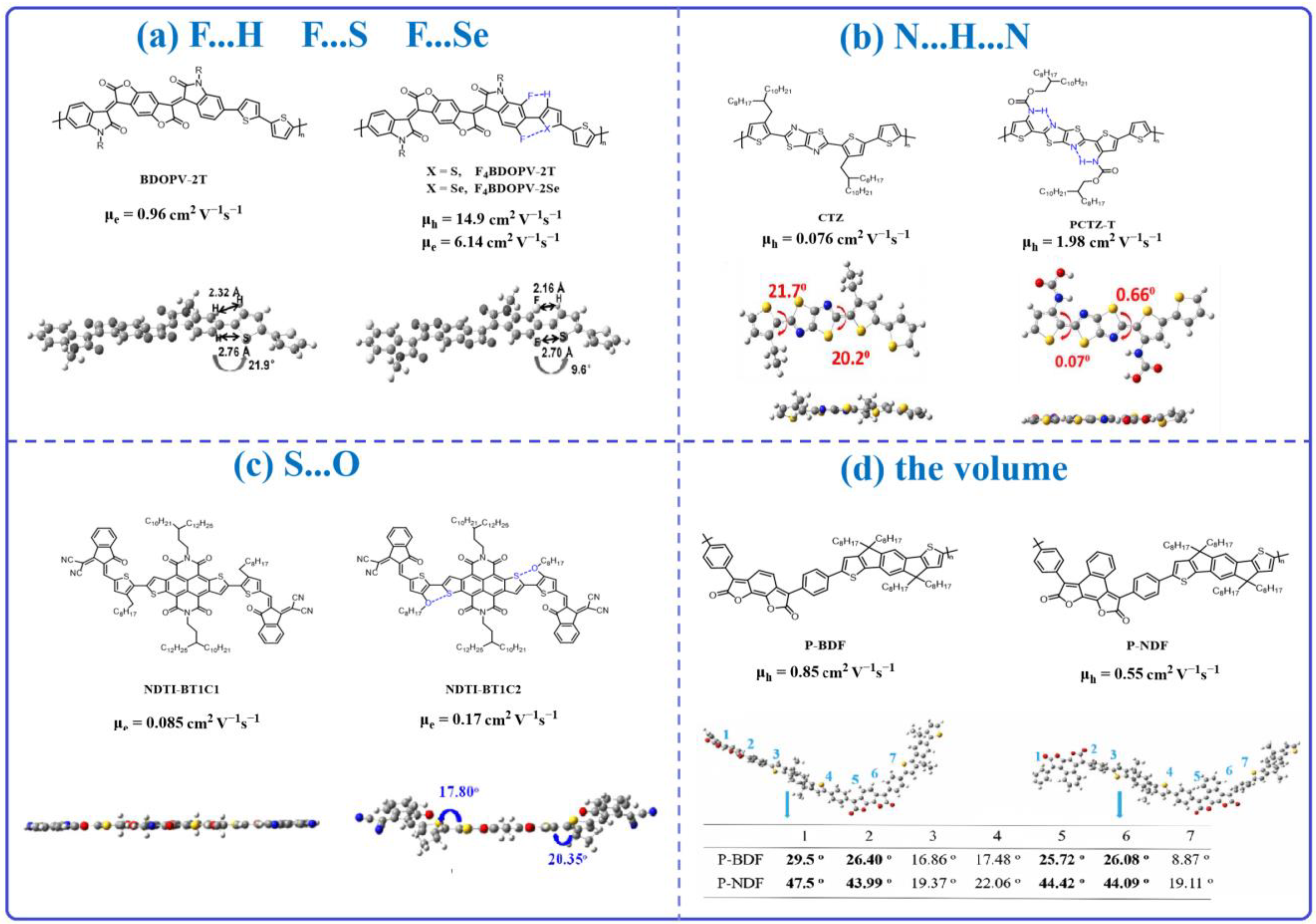

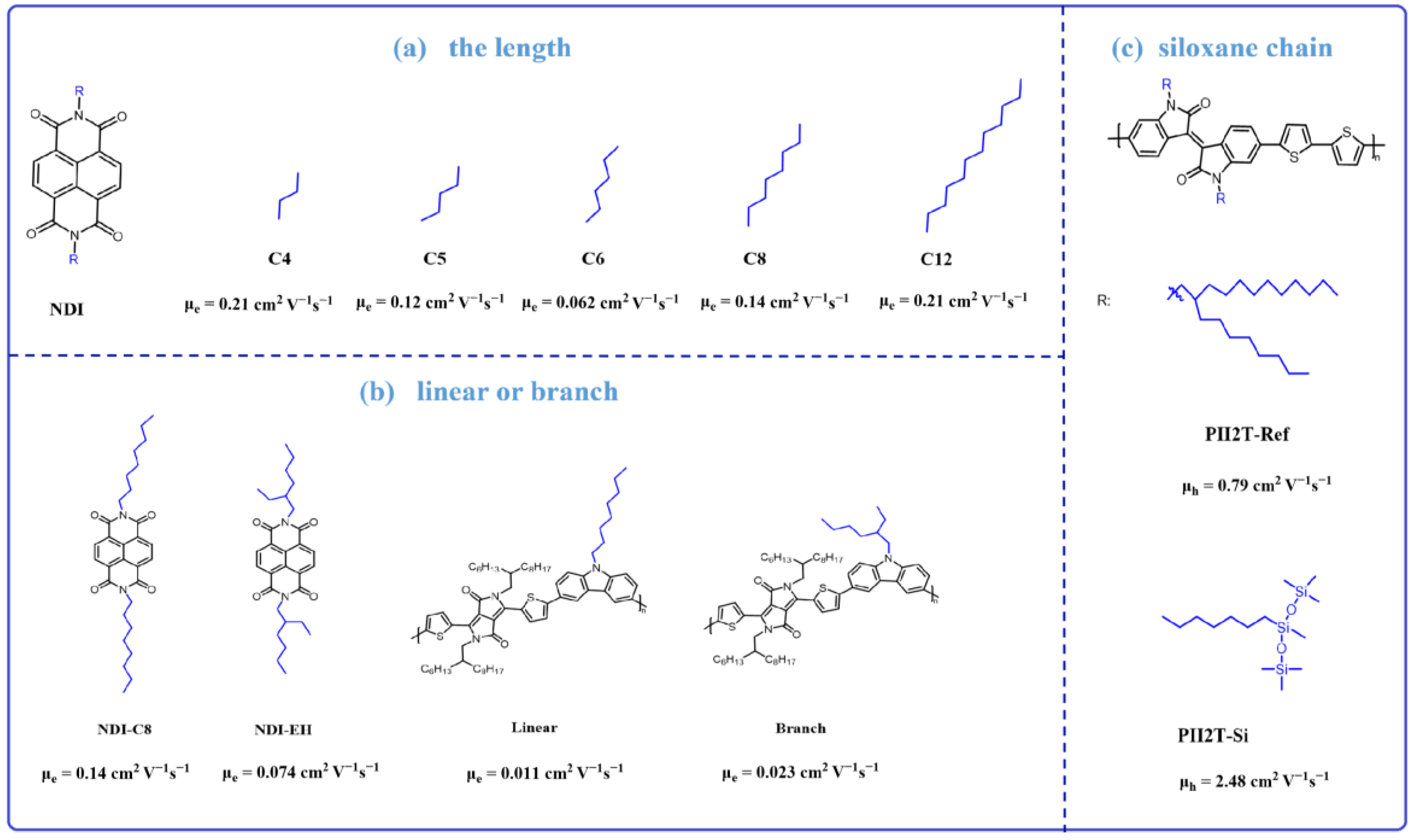
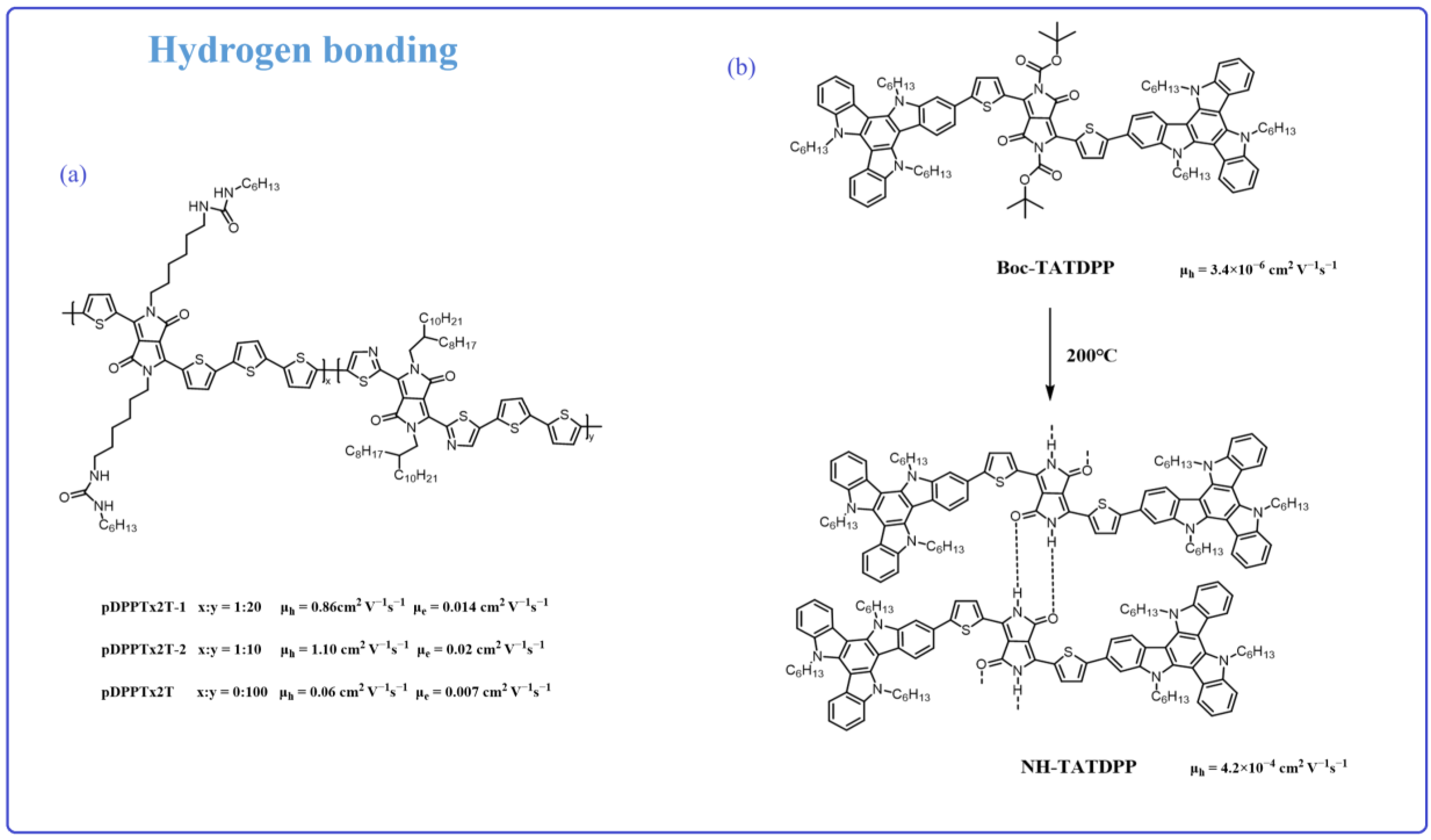
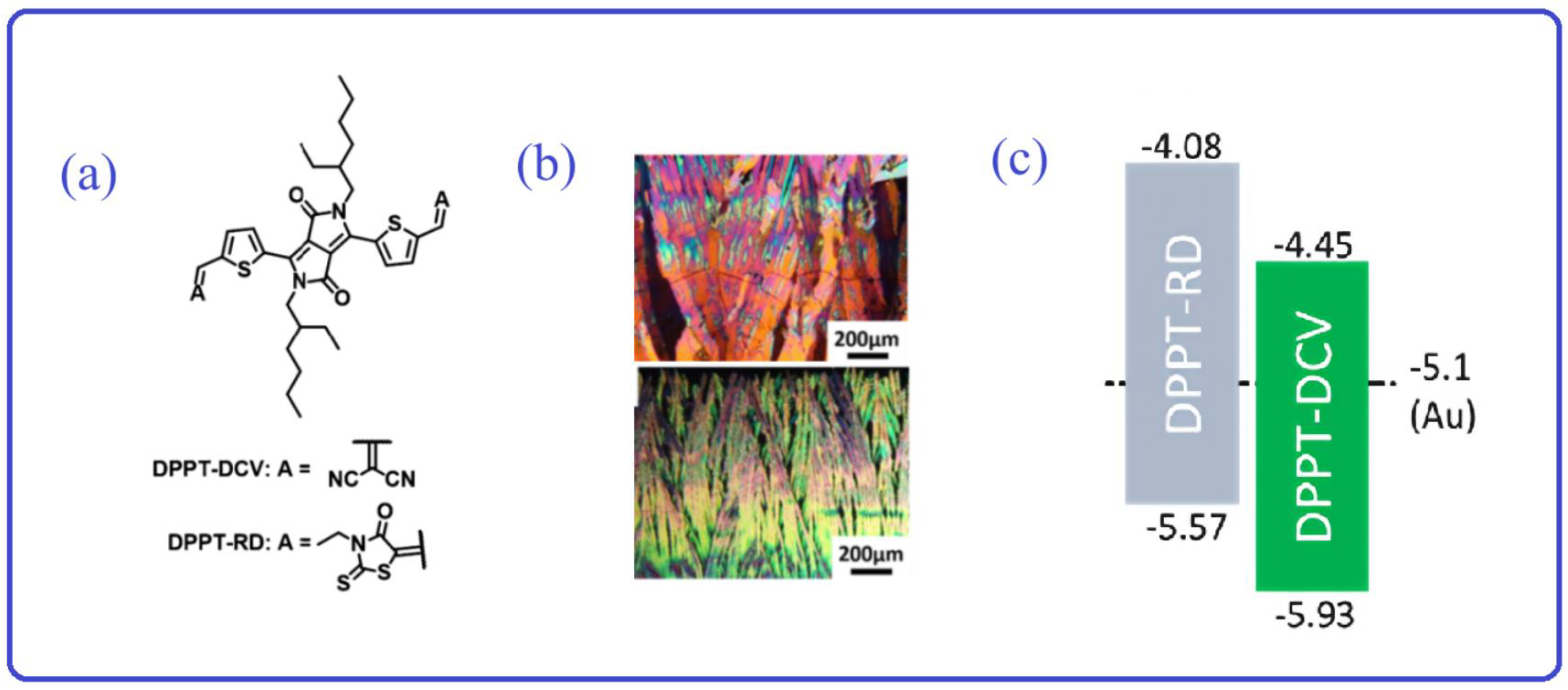
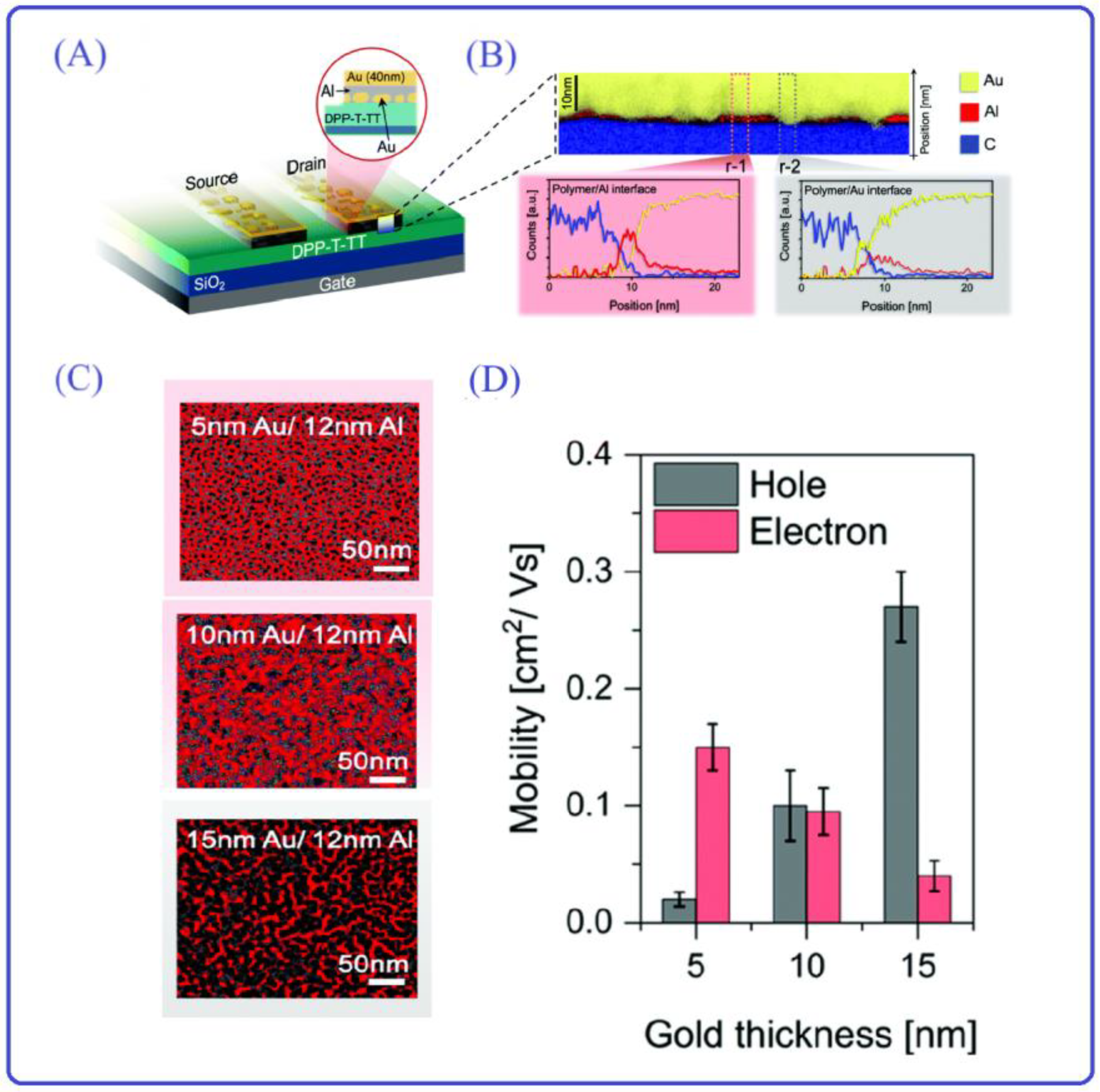
| OFETs | μ(h)max(cm2V−1s−1) | μ(e)max(cm2V−1s−1) | Ref. |
|---|---|---|---|
| II-C6 | 7.1 × 10−4 | 4.1 × 10−5 | [51] |
| TII-C6 | 1.6 × 10−5 | 1.3 × 10−4 | [51] |
| BTII-C6 | 0.095 | 5.8 × 10−3 | [51] |
| DPP | 0.02 | [52] | |
| BDP | 0.09 | [52] | |
| NDP | 0.26 | [52] | |
| P(AzIDT-C6) | 0.016 | [53] | |
| P(AzIDT-PhC6) | 0.12 | [53] | |
| P(AzIDTT-PhC6) | 0.46 | [53] | |
| BDOPV-2T | 0.96 | [59] | |
| F4BDOPV-2T | 14.9 | [59] | |
| F4BDOPV-2Se | 6.14 | [59] | |
| CTZ | 0.076 | [60] | |
| PCTZ-T | 1.98 | [60] | |
| NDTI-BT1C1 | 0.085 | [61] | |
| NDTI-BT1C2 | 0.17 | [61] | |
| P-BDF | 0.85 | [64] | |
| P-NDF | 0.55 | [64] | |
| PDPPFT | 0.78 | 0.24 | [66] |
| PTFDFT | 1.08 | 2.23 | [66] |
| PBDTT-DPP | 4.36 × 10−3 | [67] | |
| PBDTT-DPPFu | 1.15 × 10−2 | [67] | |
| NDI-C4 | 0.21 | [70] | |
| NDI-C5 | 0.12 | [70] | |
| NDI-C6 | 0.062 | [70] | |
| NDI-EH | 0.074 | [70] | |
| NDI-C8 | 0.14 | [70] | |
| NDI-C12 | 0.21 | [70] | |
| Linear | 1.1 × 10−2 | [71] | |
| Branch | 2.3 × 10−2 | [71] | |
| PII2T-Ref | 0.79 | [72] | |
| PII2T-Si | 2.48 | [72] | |
| pDPPTz2T | 0.06 | 7 × 10−3 | [82] |
| pDPPTz2T-1 | 0.86 | 0.014 | [82] |
| pDPPTz2T-2 | 1.10 | 0.02 | [82] |
| Boc-TATDPP | 3.4 × 10−6 | [83] | |
| NH-TATDPP | 4.2 × 10−4 | [83] |
Disclaimer/Publisher’s Note: The statements, opinions and data contained in all publications are solely those of the individual author(s) and contributor(s) and not of MDPI and/or the editor(s). MDPI and/or the editor(s) disclaim responsibility for any injury to people or property resulting from any ideas, methods, instructions or products referred to in the content. |
© 2023 by the authors. Licensee MDPI, Basel, Switzerland. This article is an open access article distributed under the terms and conditions of the Creative Commons Attribution (CC BY) license (https://creativecommons.org/licenses/by/4.0/).
Share and Cite
Zhou, Y.; Zhang, K.; Chen, Z.; Zhang, H. Molecular Design Concept for Enhancement Charge Carrier Mobility in OFETs: A Review. Materials 2023, 16, 6645. https://doi.org/10.3390/ma16206645
Zhou Y, Zhang K, Chen Z, Zhang H. Molecular Design Concept for Enhancement Charge Carrier Mobility in OFETs: A Review. Materials. 2023; 16(20):6645. https://doi.org/10.3390/ma16206645
Chicago/Turabian StyleZhou, Yang, Keke Zhang, Zhaoyang Chen, and Haichang Zhang. 2023. "Molecular Design Concept for Enhancement Charge Carrier Mobility in OFETs: A Review" Materials 16, no. 20: 6645. https://doi.org/10.3390/ma16206645
APA StyleZhou, Y., Zhang, K., Chen, Z., & Zhang, H. (2023). Molecular Design Concept for Enhancement Charge Carrier Mobility in OFETs: A Review. Materials, 16(20), 6645. https://doi.org/10.3390/ma16206645






